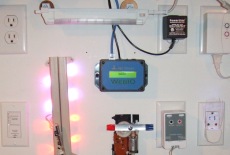WebIO Internet Home Automation
WebIO is an Internet to X10 control network gateway,
providing both local and remote Internet control
of lamps, appliances and other
electrical devices in the home or office.
Utilizing X10 technology, the WebIO sends signals
down existing AC power lines to control X10 modules.
The WebIO contains a built-in web server allowing
device control by remote users with Internet access via
Smartphone or computer running a web browser.
WebIO Internet X10 Web Server v2.0
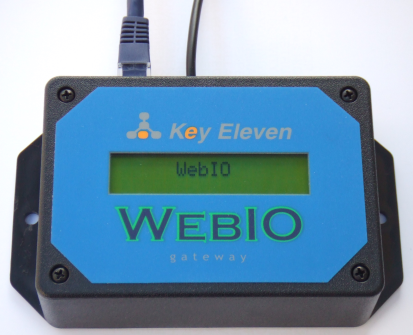 The WebIO (seen above) connects to your Ethernet network
and communicates to devices over the AC powerline.
The WebIO (seen above) connects to your Ethernet network
and communicates to devices over the AC powerline.
|
|
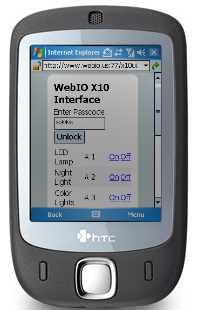 The WebIO web interface as used on a smartphone.
The WebIO web interface as used on a smartphone.
|
|
|
WebIO is built on the idea that an expensive
and complex personal computer is not needed to
provide Internet access to a control network. Instead,
WebIO is a low cost, small self-contained box
that provides all the functionality of an
Ethernet to X10 gateway and web server that is as easy to
install as a home Internet router.
WebIO version 3 with wireless temperature sensors
This new WebIO model includes all the X10 control features of WebIO
version 2.2 along with the addition of a wireless receiver for reading
of wireless temperature sensors. Version 3 also provides the
additional option of using an external wireless X10 transmitter
as an X10 transceiver or using any one of the Powerline X10
transceivers supported by version 2.2.
The diagram to the right displays many of the features, remote access,
control and monitoring options available for use with WebIO v3.
|
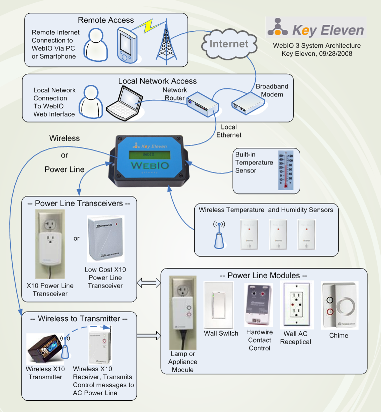
System diagram of WebIO version 3
|
Controlling X10 Devices
The WebIO web browser interface provides two methods for controlling
X10 Devices.
The Control X10 Labeled Devices page (shown to the right) allows for
easy control of X10 On/Off commands for user defined devices.
Another method for control is to use the
WebIO Send X10 Codes web page which allows for many more control
commands and device state query functions. Also allowing manually selecting
X10 device House code, Unit code, and Command to be sent,
timer repeat funtions and ability to send a command to multiple units.
|
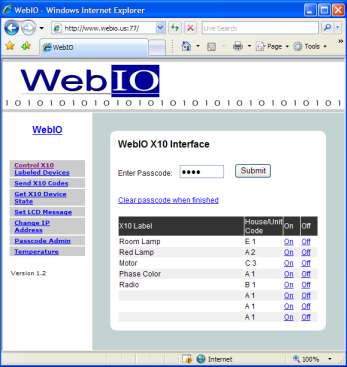
|
WebIO TCP/IP Networking
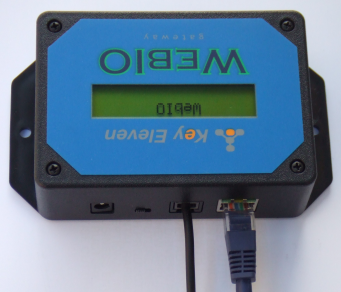
Back view of WebIO (above) showing Ethernet, X10 transceiver
connection, program/lock switch and optional power connector.
|
WebIO provides an RJ45 interface for an Ethernet connection
to a local area network. An IP address may be assigned to WebIO
from a DHCP server or a static IP address can be set via the WebIO
web interface or PC WebIO Setup utility software.
|
For remote monitoring and control, WebIO requires a routable
Internet connection, allowing a user to connect to the WebIO
from anywhere in the world via Internet browser.
WebIO network access security is provided via user assignable
passcode. WebIO configuration settings are protected from
unauthorized web access via program-mode switch located on
the WebIO back connection panel. Additional security requires
user supplied VPN device or other network security systems.
© 2008 Key Eleven
|
|
|
|
WebIO version 3.0 demonstration.
While connected to a streaming video
camera, test drive a WebIO and watch
lamps and other devices change state as you
operate an internet connected WebIO Internet server.
|
|
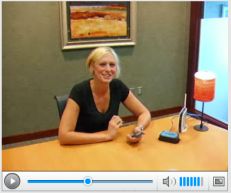
Watch WebIO Mobile Video
WebIO is Smartphone friendly! Just use your phones
web browser to remotely control your device network.
WebIO for Mobile
|
|
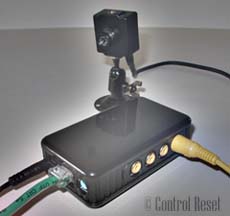
-- Now Available --
The four camera video over Internet server.
With optional integration of WebIO and IP Video
server, you can now control devices and view video
over one integrated web interface.
IP Video Server
|
|
|
WebIO has been updated with serveral new features,
including an X10 timer function, X10 repeat,
simultaneous control of multiple X10 devices,
and new CGI program interfaces
for 3rd party software controls and peristance of device labels
in non-votile memory.
Check out the new WebIO User Manual
for version 2.0
Documentation
|
|

|
New to WebIO version 3 Support for wireless
temperature sensors. Now you can remotely check
the temperature of your lake home, receive alert notifications and set control automation.
The WebIO web interface displays temperature and humidity of 3 wireless sensors.
|
WebIO-TM PC software supports more than 10 wireless sensors.
Sensor readings are also sent over the TCP/IP network.
More on version 3
|
|
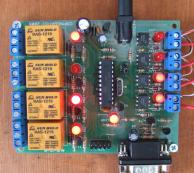
The Relay/Input board is a plug-in add-on to WebIO v3.6.
Includes 4 SPDT relays controlled by WebIO.
Also includes 4 inputs for WebIO automation and email
notification with WebIO-TM PC software.
See the
Relay add-on board here
|
|
|
WebIO contains a built in Web Server on a chip
for simple out-of-the-box operation,
no PC or server required.
But with the WebIO HTTP interface,
WebIO can also be easily integrated with
your own web page, web application or PC software.
WebIO Server software examples are available for
integration with existing web sites.
Example scripts are available using PHP,
Java, Visual Basic, HTML and Javascrip/AJAX.
Check out software development
Software Development
|
|
|
 The WebIO (seen above) connects to your Ethernet network
and communicates to devices over the AC powerline.
The WebIO (seen above) connects to your Ethernet network
and communicates to devices over the AC powerline.
 The WebIO web interface as used on a smartphone.
The WebIO web interface as used on a smartphone.



